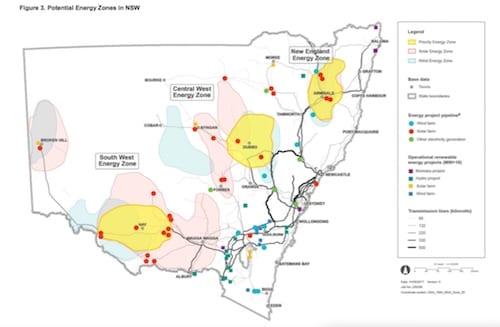The New South Wales government has identified three key regional energy zones that could provide 77,000MW (77GW) of wind and solar capacity – enough, it says, to provide for a “modern energy system”.
The NSW estimates are contained in its submission to the Integrated System Plan, a major work undertaken by the Australian Energy Market Operator to plan for a grid that will likely be dominated by renewables in the near future.
The NSW submission identifies three key renewable energy zones – in New England, the central west, and in the south-west – all are located in federal National Party seats, including those of the past and current NP leaders, the climate-skeptics Barnaby Joyce and Michael McCormack.
The NSW Coalition government considers the south-west region to be the richest resource, with some 40GW of solar and 3GW of wind capacity that could be unlocked with upgraded transmission lines.
“This zone is ideally located to unlock a large pipeline of renewable energy projects currently in the project pipeline between Griffith and Deniliquin, as well as to open up areas further west with even stronger resources,” the submission says.
The central-west zone is seen to hold solar and wind capacities of 15,000MW and 3,000MW respectively, and already hosts the country’s largest solar farm, Nyngan (102MW, but soon to be overtaken), with five under construction and another 3,400MW approved or seeking planning approval.
The NSW report identifies 12,000MW of solar capacity and 4,000MW of wind capacity, and is already host to the White Rock wind and solar projects, the Sapphire wind project (and planned solar and battery additions), and other projects.
NSW is currently the state with the biggest load of any state grid, as well as the greatest dependence on coal-fired generation, and on electricity imports from neighbouring states, particularly Queensland.
It says that developing these energy zones can place downward pressure on wholesale energy prices and support regional development.
“The NSW Government is committed to a secure, affordable and clean energy future for households and businesses and supports an orderly, private-sector led transition to a modern energy system,” it says.
It notes that its coal fleet will be diminished with the expected retirement of ageing coal-fired generators in the 2020s and 2030s.
This, combined with increasing demand for energy at peak times ,will require the development of replacement generation capacity.
But planning is essential. The government says there are some 15,000MW of proposals already in place, but much in areas where there is no grid capacity to absorb. Hence the need for planning renewable energy zones or hubs.
“Combined, the three priority Energy Zones could unlock 77,000 megawatts (MW) of new generation capacity. Complemented by emerging energy technologies, energy efficiency and demand response, this would be more than enough generation to meet future energy needs.”
The push for renewable energy zones has also been embraced by Transgrid, the operator of the main transmission lines, which has argued that the shift to 100 per cent renewables is perfectly feasible and affordable.
AEMO is also a strong supporter of renewable energy zones, and its Integrated System Plan is viewed as a critical component – and is looking at scenarios that contemplate a 50 per cent reduction in electricity emissions by 2030, far beyond that entertained by the current federal government.












